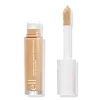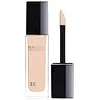What's inside
What's inside
 Key Ingredients
Key Ingredients

 Benefits
Benefits

 Concerns
Concerns

 Ingredients Side-by-side
Ingredients Side-by-side

Water
Skin ConditioningCyclopentasiloxane
EmollientPropylene Glycol
HumectantButylene Glycol Dicaprylate/Dicaprate
EmollientTrimethylsiloxysilicate
EmollientPolyglyceryl-4 Diisostearate/Polyhydroxystearate/Sebacate
EmulsifyingEthylhexyl Hydroxystearate
EmollientCetyl PEG/PPG-10/1 Dimethicone
EmulsifyingPropylene Glycol Dibenzoate
Skin ConditioningPEG-10 Dimethicone
Skin ConditioningDisteardimonium Hectorite
StabilisingSodium Chloride
MaskingPhenoxyethanol
PreservativeDimethicone
EmollientAcrylates/Polytrimethylsiloxymethacrylate Copolymer
Skin ConditioningDimethicone/Vinyl Dimethicone Crosspolymer
Skin ConditioningPerfluorooctyl Triethoxysilane
Trihydroxystearin
Skin ConditioningSilica
AbrasiveCaprylyl Glycol
EmollientEthylhexylglycerin
Skin ConditioningDisodium EDTA
Sodium Hyaluronate
HumectantRosa Damascena Flower Water
MaskingCI 77891
Cosmetic ColorantIron Oxides
Water, Cyclopentasiloxane, Propylene Glycol, Butylene Glycol Dicaprylate/Dicaprate, Trimethylsiloxysilicate, Polyglyceryl-4 Diisostearate/Polyhydroxystearate/Sebacate, Ethylhexyl Hydroxystearate, Cetyl PEG/PPG-10/1 Dimethicone, Propylene Glycol Dibenzoate, PEG-10 Dimethicone, Disteardimonium Hectorite, Sodium Chloride, Phenoxyethanol, Dimethicone, Acrylates/Polytrimethylsiloxymethacrylate Copolymer, Dimethicone/Vinyl Dimethicone Crosspolymer, Perfluorooctyl Triethoxysilane, Trihydroxystearin, Silica, Caprylyl Glycol, Ethylhexylglycerin, Disodium EDTA, Sodium Hyaluronate, Rosa Damascena Flower Water, CI 77891, Iron Oxides
Water
Skin ConditioningC9-12 Alkane
SolventCaprylic/Capric Triglyceride
MaskingPropanediol
SolventGlycerin
HumectantPolyglyceryl-6 Polyricinoleate
EmulsifyingDicaprylyl Ether
EmollientPentylene Glycol
Skin ConditioningSilica
AbrasivePolyglyceryl-10 Decaisostearate
EmollientSynthetic Fluorphlogopite
Trimethylsiloxysilicate
EmollientIris Florentina Root Extract
MaskingPolyglyceryl-2 Isostearate
EmulsifyingDisteardimonium Hectorite
StabilisingSodium Myristoyl Glutamate
CleansingStearalkonium Hectorite
Gel FormingSodium Chloride
MaskingButylene Glycol
HumectantLecithin
EmollientHydroxyacetophenone
AntioxidantSodium Benzoate
MaskingPropylene Carbonate
SolventPolyhydroxystearic Acid
EmulsifyingHydrolyzed Viola Tricolor Extract
Skin ProtectingAluminum Hydroxide
EmollientParfum
MaskingTocopherol
AntioxidantIsostearic Acid
Cleansing1,2-Hexanediol
Skin ConditioningCaprylyl Glycol
EmollientPolyglyceryl-3 Polyricinoleate
EmulsifyingAchillea Millefolium Extract
CleansingXanthan Gum
EmulsifyingTropaeolum Majus Flower/Leaf/Stem Extract
Skin ConditioningCitric Acid
BufferingPotassium Sorbate
PreservativeCI 77891
Cosmetic ColorantCI 77491
Cosmetic ColorantCI 77492
Cosmetic ColorantCI 77499
Cosmetic ColorantWater, C9-12 Alkane, Caprylic/Capric Triglyceride, Propanediol, Glycerin, Polyglyceryl-6 Polyricinoleate, Dicaprylyl Ether, Pentylene Glycol, Silica, Polyglyceryl-10 Decaisostearate, Synthetic Fluorphlogopite, Trimethylsiloxysilicate, Iris Florentina Root Extract, Polyglyceryl-2 Isostearate, Disteardimonium Hectorite, Sodium Myristoyl Glutamate, Stearalkonium Hectorite, Sodium Chloride, Butylene Glycol, Lecithin, Hydroxyacetophenone, Sodium Benzoate, Propylene Carbonate, Polyhydroxystearic Acid, Hydrolyzed Viola Tricolor Extract, Aluminum Hydroxide, Parfum, Tocopherol, Isostearic Acid, 1,2-Hexanediol, Caprylyl Glycol, Polyglyceryl-3 Polyricinoleate, Achillea Millefolium Extract, Xanthan Gum, Tropaeolum Majus Flower/Leaf/Stem Extract, Citric Acid, Potassium Sorbate, CI 77891, CI 77491, CI 77492, CI 77499
 Reviews
Reviews

Ingredients Explained
These ingredients are found in both products.
Ingredients higher up in an ingredient list are typically present in a larger amount.
Caprylyl Glycol is a humectant and emollient, meaning it attracts and preserves moisture.
It is a common ingredient in many products, especially those designed to hydrate skin. The primary benefits are retaining moisture, skin softening, and promoting a healthy skin barrier.
Though Caprylyl Glycol is an alcohol derived from fatty acids, it is not the kind that can dry out skin.
This ingredient is also used as a preservative to extend the life of products. It has slight antimicrobial properties.
Learn more about Caprylyl GlycolCi 77891 is a white pigment from Titanium dioxide. It is naturally found in minerals such as rutile and ilmenite.
It's main function is to add a white color to cosmetics. It can also be mixed with other colors to create different shades.
Ci 77891 is commonly found in sunscreens due to its ability to block UV rays.
Learn more about CI 77891Disteardimonium Hectorite comes from the clay mineral named hectorite. It is used to add thickness to a product.
It can also help stabilize a product by helping to disperse other ingredients.
Hectorite is a rare, white clay mineral.
Learn more about Disteardimonium HectoriteSilica, also known as silicon dioxide, is a naturally occurring mineral. It is used as a fine, spherical, and porous powder in cosmetics.
Though it has exfoliant properties, the function of silica varies depending on the product.
The unique structure of silica enhances the spreadability and adds smoothness, making it a great texture enhancer.
It is also used as an active carrier, emulsifier, and mattifier due to its ability to absorb excess oil.
In some products, tiny microneedles called spicules are made from silica or hydrolyzed sponge. When you rub them in, they lightly polish away dead skin layers and enhance the penetration of active ingredients.
Learn more about SilicaChances are, you eat sodium chloride every day. Sodium Chloride is also known as table salt.
This ingredient has many purposes in skincare: thickener, emulsifier, and exfoliator.
You'll most likely find this ingredient in cleansers where it is used to create a gel-like texture. As an emulsifier, it also prevents ingredients from separating.
There is much debate on whether this ingredient is comedogenic. The short answer - comedogenic ratings don't tell the whole story. Learn more about comegodenic ratings here.
The concensus about this ingredient causing acne seems to be divided. Research is needed to understand if this ingredient does cause acne.
Scrubs may use salt as the primary exfoliating ingredient.
Learn more about Sodium ChlorideThis silicone is an emollient. Emollients create a thin film on the skin to prevent moisture from escaping.
It is not soluble in water and helps increase water-resistance in products.
According to a manufacturer, it can blend seamlessly with silicone oils, such as Cyclopentasiloxane.
Learn more about TrimethylsiloxysilicateWater. It's the most common cosmetic ingredient of all. You'll usually see it at the top of ingredient lists, meaning that it makes up the largest part of the product.
So why is it so popular? Water most often acts as a solvent - this means that it helps dissolve other ingredients into the formulation.
You'll also recognize water as that liquid we all need to stay alive. If you see this, drink a glass of water. Stay hydrated!
Learn more about Water